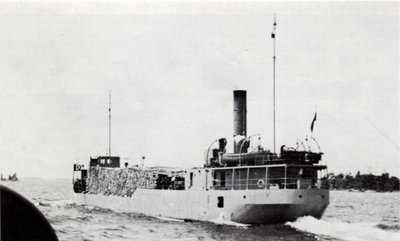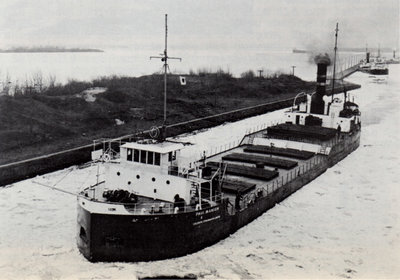Table of Contents
Seldom do we feature two Ships of the Month in one issue, but we do so in this case because we had a specific request from a reader to present the history of the canal steamer PAUL MANION. Unfortunately, this ship had a rather uneventful career and, as not much can be said about her, we thought we had best feature her in an issue when we had another relatively short Ship of the Month to go with it. Thus, two for one this month!
In 1928, Capt. Robert Scott Misener and his Chief Engineer, John O. McKellar, who already had been involved in the shipping industry together for more than a decade, incorporated a new firm known as Sarnia Steamships Ltd., of Sarnia, Ontario. The company, with authorized capital of $800,000, was formed with the financial backing of John J. Boland, Jr., of Buffalo, and his father, John J. Boland, Sr. During its first two years of operation, the firm purchased six canal-sized steamers from Swan, Hunter and Wigham Richardson Ltd., Wallsend-on-Tyne, England. Acquired in 1928 were JOHN J. BOLAND JR. (I) and SCOTT MISENER (I), Hulls 1282 and 1290, while in 1929 there followed JOHN O. McKELLAR (I), C. H. HOUSON, RALPH GILCHRIST and JOSEPH P. BURKE, Hulls 1369, 1371f 1373 and 1375, respectively.
The Swan Hunter yard had become masterful in the "mass production" of canallers, and its products, which were highly utilitarian in design, found their way into many Canadian fleets. The ships had full forecastles, surmounted by squarish texas and five-windowed pilothouse with flying bridgewings. The spar deck was "stepped", that is, the entire stern section, including the last hatch, was raised. There were six hatches in all, serving two holds. A rather "bald" after cabin sat on the raised quarterdeck, and from it sprouted a tall stack, thin and almost without rake. Pipe masts were set just abaft the pilothouse and funnel. The deck rails were all open, with the exception of a small closed section right forward on the forecastle head.
The second vessel in the second group was launched on Friday, January 25th, 1929, but seems to have suffered no ill effects from having been launched on a Friday. She was christened C. H. HOUSON to honour a gentleman who, we believe, was an executive of the Dominion Sugar Company Ltd., a firm with which Misener had close connections and for which its steamer CLAREMONT had specifically operated. The HOUSON was enrolled as C.149494 at Sarnia, which would always be her port of registry.

Photo by J. H. Bascom shows C. H. HOUSON laying up for the winter along the north outer wall of the Toronto Ship Channel, November 28, 1937.
The steamer was 252.8 feet in length (259.0 feet overall), 43.4 feet in the beam and 17.8 feet in depth, with tonnage of 1927 Gross and 1147 Net. She was powered by a triple-expanion engine with cylinders of 15, 25 and 40 inches and a stroke of 33 inches, which was built for her by the shipyard. Steam at 180 p.s.i. was supplied by two coal-fired, single-ended, Scotch boilers, which measured 10.1 feet by 10.1 feet, and also were built by Swan Hunter. The HOUSON was painted in usual Misener colours, with a black hull, white forecastle and cabins, and a black stack with two silver bands.
C. H. HOUSON crossed the Atlantic Ocean under her own power and, although we have no confirmation of this, we suspect that she brought with her a cargo of coal, as many canallers did on their delivery trips. She carried a variety of cargoes on the lakes for Sarnia Steamships, notably grain, coal and pulpwood, as she operated through the small locks of the old canals.
The steamer operated uneventfully, and we know of only two incidents that marred her record. On our photopage can be seen a view of the HOUSON laying up for the winter on November 28, 1937. She was placed on the north wall of the Toronto Ship Channel, outside the Cherry Street Bridge. On New Year's Eve, a severe storm tore several ships from their moorings and C. H. HOUSON was one of them. She did some rather severe damage to her port bow, and a press photo published on March 29, 1938, showed her with her bow all opened up for the replacement of the damaged plating and ribs.
Then, on December 2, 1942, the HOUSON went aground in heavy weather on Slate Island in Lake Superior, whilst downbound from Fort William for Buffalo with a storage cargo of flax, and under the command of Capt. W. A. Stewart. She was freed later the same day by another Misener steamer, BAYTON, and she then proceeded to Quebec Harbour on Michipicoten Island for inspection. Fortunately, she sustained very little damage in the stranding.

Unusual view of C. H. HOUSON in wartime grey livery, upbound with a load of pulpwood, was taken in the St. Lawrence River by Rowley W. Murphy.
On April 22, 1949, C. H. HOUSON was renamed (b) PAUL MANION in honour of Paul Desaulniers Manion, an employee of the traffic department of Sarnia Steamships, who would become traffic manager in 1952. The Bolands disposed of their interest in Sarnia Steamships to Capt. Misener in 1951, and the entire fleet was then merged into Colonial Steamships Ltd., Port Colborne, another company which Misener had operated since 1933. The only change for the MANION was the painting of the new owner's name on her forecastle.
During late March of 1953, while she lay on the west wall above Lock Eight in the Welland Canal at Port Colborne, with a storage grain cargo in her holds, PAUL MANION was given a new stack. Larger than the original and fitted with a liner (which the original did not possess), it was still virtually unraked but did sport a rather noticeable cowl around its top.

Scenic photo by Gordon Macaulay, courtesy Ron Beaupre, caught PAUL MANION downbound in ice above the Canadian Soo Lock.
In 1959, the Misener shipping interests were reorganized as Scott Misener Steamships Ltd., Port Colborne, but that name never appeared on the bows of PAUL MANION. The Misener fleet was one of the first to dispose of its canallers after the opening of the new St. Lawrence Seaway that year, and they soon found their way to other operators or to various scrapyards. Many of the canallers were placed in a reserve fleet that was laid up in the old Galops Canal above Cardinal, and one of these was PAUL MANION.
In 1961, S. Spiegel acquired her for his Crawford Metals Company, Belleville, and like most of the others in Misener's Galops mothball fleet, PAUL MANION was soon taken to Deseronto and there was cut up for scrap.
Previous Next
Return to Home Port or Toronto Marine Historical Society's Scanner
Reproduced for the Web with the permission of the Toronto Marine Historical Society.